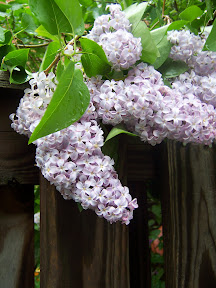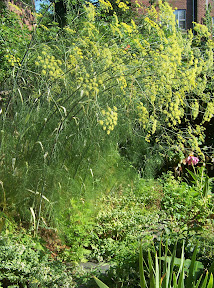Favorite smells—stories and activities
By Peggy Ashbrook
Posted on 2009-10-01
 I love the way two-year-olds inexpertly sniff, to sense an odor. They crinkle up their nose and snort, or gasp, and blink their eyes, not quite putting it all together to inhale through their nose. Yet they have an expert sense of smell—nothing comforts them like their favorite “lovey,” a much worn toy or blanket that has achieved a certain smell.
I love the way two-year-olds inexpertly sniff, to sense an odor. They crinkle up their nose and snort, or gasp, and blink their eyes, not quite putting it all together to inhale through their nose. Yet they have an expert sense of smell—nothing comforts them like their favorite “lovey,” a much worn toy or blanket that has achieved a certain smell.
What did your grandmother’s house smell like—boxwood bushes along the sidewalk and old feather pillows on the window seat like mine? I loved the smell of those bushes but my father thought they smelled like cat urine! My great aunt used to light her late husband’s cigars because the smell brought his presence closer. Smelling muddy ooze left by a flooding creek brought the memories of my childhood closer, reminding me of watching the pattern of water-flow past overfull creek banks. The scent of lilac flowers reminds me of my childhood home too.
Scientists study the way smells affect people and our perceptions of smells. In the October Early Years column in Science and Children, I write about a smelling activity using lemons, cinnamon, onions, and coffee beans. In my ten+ years of using this activity, I have never had a student who was allergic to any of those foods. There is always a first time so I check every class.
Here are a few more ideas for engaging students’ sense of smell as they explore the world. Please teach the Safe Smelling method of wafting (waving) an odor towards your nose with your hand instead of sniffing directly from a container.
Cinnamon Shapes, a smell recipe
½ cup of cinnamon
½ cup of applesauce
2 Tablespoons of white school glue
Ground cinnamon lifts into the air very easily so monitor students closely as they slowly add the powder to the other two ingredients. Have the children touch each ingredient and talk about how it feels. Is it dry? Wet? Mix all three ingredients together and roll out onto wax or parchment paper to about 5 mm thick. Have children use a cookie cutter to cut out shapes. Roll out the scraps again and cut more shapes. Poke a hole near the edge of each shape so when they are dry, you can put a loop of ribbon through the hole to hang the shape. Youngest children can just make a pancake shape from a ball of dough. Even after completely dry (air dry for several days) the cinnamon smell is strong. This recipe makes about six small shapes.
Smelling, then planting herbs
 What if you had to live in a small space for a long time with no windows to let in fresh air? Astronauts living in space breathe the same air over and over. A machine cleans the air and tries to keep the right balance of gases. NASA has many ideas for science activities, including one about using our sense of smell to identify herbs and spices. We can not be sure what’s in a container so it’s best to always smell substances the “scientific way”. Hold the open container about six inches away from your face, and with your free hand fan the air over the container toward you. The smell from the substance in the container will be mixed in the air and you will get a gentle sample of the substance—not enough to sting your nose or make your eyes water.
What if you had to live in a small space for a long time with no windows to let in fresh air? Astronauts living in space breathe the same air over and over. A machine cleans the air and tries to keep the right balance of gases. NASA has many ideas for science activities, including one about using our sense of smell to identify herbs and spices. We can not be sure what’s in a container so it’s best to always smell substances the “scientific way”. Hold the open container about six inches away from your face, and with your free hand fan the air over the container toward you. The smell from the substance in the container will be mixed in the air and you will get a gentle sample of the substance—not enough to sting your nose or make your eyes water.
Some herbs are winter hardy in many regions and can be planted in the fall: oregano, thyme, sage, rosemary, and garlic bulbs. The children can rub the plants’ leaves to release the smell, and plant them outside to make a “smelling” garden. After the last frost date in spring (also see the USDA plant hardiness map), plant tender herbs such as basil, fennel, and dill. Much more can be learned from The Herb Society of America’s Essential Guide to Growing and Cooking with Herbs, edited by Katherine K. Schlosser (Louisiana State University Press 2007). See the society’s website.
Read these books aloud to open up discussion and introduce vocabulary to your class:
- Dog Breath: Horrible Trouble With Hally Tosis by Dav Pilkey (Blue Sky Press 1994). Young children may not understand the title’s play on words but they will get the humor of a dog with smelly breath saving the day. Ask your class, “When is our sense of smell useful?”
- The Happy Day by Ruth Krauss, Marc Simont (Illustrator) (HarperCollins 1949). Children can guess what the animals are smelling but they will be surprised!
- Smelling Things (Rookie Read-About Science) by Allan Fowler (Childrens Press 1991). An easy reader introduction to the sense of smell. Fowler’s books pair simple, pertinent details about the topic with informative photographs.
- Two Eyes a Nose and a Mouth by Roberta Intrater (Cartwheel Books 1995). In a book full of photographs and rhyming text celebrating the variety in human faces, one page with repeated photos of just one face catches our attention, asks us to “imagine how dull the world would be, if everyone looked like you or me” and reminds us “…the variety is just fine.” Young children will enjoy pointing to the part of our body that we sense smells with, or see/hear/taste with.
- What Can I Smell? by Sue Barraclough (Raintree 2005). Opening with the question, “What is your favorite breakfast smell?”, this book invites discussion of familiar smells.
Your class might want to write and illustrate a book about odors they have smelled—their favorites and the ones they do not appreciate. Share your experiences with sense of smell activities….make a comment!
Peggy
Disclaimer: The views expressed in this blog post are those of the author(s) and do not necessarily reflect the official position of the National Science Teaching Association (NSTA).



